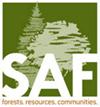Woodboring Beetle (Buprestidae, Cerambycidae) Responses to Hurricane Michael in Variously Damaged Southeastern US Pine Plantations
IF 1.5
4区 农林科学
Q2 FORESTRY
引用次数: 0
Abstract
In October 2018, catastrophic Hurricane Michael caused $1.7 billion in damage to standing timber in Florida, USA. To inform recovery efforts, varying levels of damaged (low, moderate, and high) slash pine (Pinus elliottii Engelm) stands were sampled for woodboring beetles (Coleoptera: Buprestidae; Cerambycidae). These beetles generally colonize stressed and damaged trees, and their larval tunneling activities reduce the value of timber salvaged post disturbance. From 2019 to 2020, 3,810 adults of 32 species were trapped. Acanthocinus obsoletus Olivier and Monochamus sp. complex (M. titillator Fabricius; M. carolinensis Olivier) comprised 86% of all catches. Approximately 50% and 60% more woodborers, especially Monochamus sp., were trapped in moderate-damage stands in 2019 than in high- and low-damage stands, respectively. This trend was not present in 2020. From 2019 to 2020, total catches increased by ~29%, reflected by increases in Monochamus sp. and Xylotrechus sagittatus Germar. In 2019, high-damage stands had the greatest species richness, followed by low- and moderate-damage stands. Species composition in 2019 did not differ among variously damaged stands, but was more heterogeneous in low-damage than high-damage stands in 2020. Results indicate that timely salvage harvesting of moderate- and high-damage stands after catastrophic wind disturbances may lower the economic impacts by subcortical woodboring beetles.美国东南部不同受损松林中蛀木甲虫对飓风“迈克尔”的响应
2018年10月,灾难性飓风“迈克尔”给美国佛罗里达州的立木造成了17亿美元的损失。为了为恢复工作提供信息,对不同程度(低、中、高)受损的湿地松(Pinus elliottii Engelm)林分进行了蛀木甲虫(鞘翅目:布氏科;天牛科)。这些甲虫通常在受压和受损的树木上定居,它们的幼虫挖洞活动降低了干扰后被回收的木材的价值。2019 - 2020年共捕获32种成虫3810只。棘棘虫(cananthocinus obsoletus Olivier)和棘棘虫(Monochamus sp. complex)卡罗林螺(M. carolinensis Olivier)占总渔获量的86%。2019年,被困在中度危害林分的蛀虫,尤其是单夜蛾,分别比高危害林分和低危害林分的蛀虫多出约50%和60%。这一趋势在2020年并不存在。从2019年到2020年,总捕获量增加了约29%,主要表现为单足鼠和德国矢状木鼠的增加。2019年,高损害林分物种丰富度最高,其次是低、中损害林分。2019年不同毁害林分物种组成差异不大,但2020年低毁害林分物种组成异质性大于高毁害林分。结果表明,对中高损失率林分进行及时的回收采伐,可以降低皮质下伐木甲虫对林分的经济影响。
本文章由计算机程序翻译,如有差异,请以英文原文为准。
求助全文
约1分钟内获得全文
求助全文
来源期刊

Forest Science
农林科学-林学
CiteScore
2.80
自引率
7.10%
发文量
45
审稿时长
3 months
期刊介绍:
Forest Science is a peer-reviewed journal publishing fundamental and applied research that explores all aspects of natural and social sciences as they apply to the function and management of the forested ecosystems of the world. Topics include silviculture, forest management, biometrics, economics, entomology & pathology, fire & fuels management, forest ecology, genetics & tree improvement, geospatial technologies, harvesting & utilization, landscape ecology, operations research, forest policy, physiology, recreation, social sciences, soils & hydrology, and wildlife management.
Forest Science is published bimonthly in February, April, June, August, October, and December.
 求助内容:
求助内容: 应助结果提醒方式:
应助结果提醒方式:


